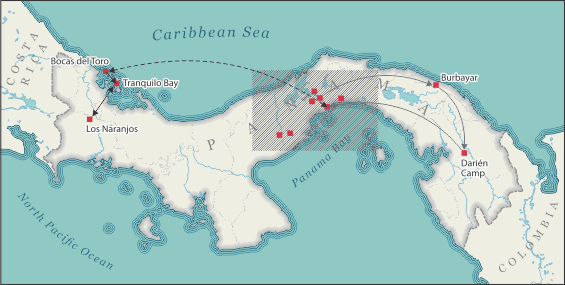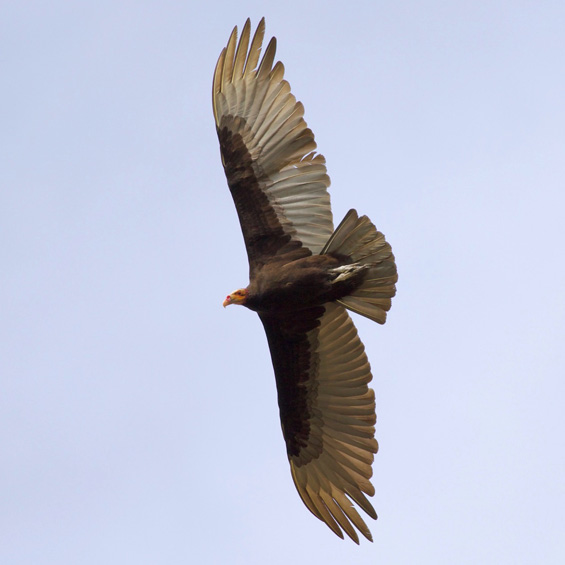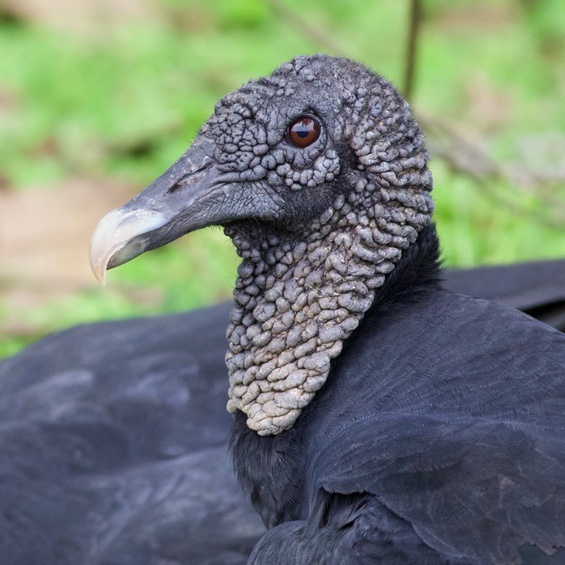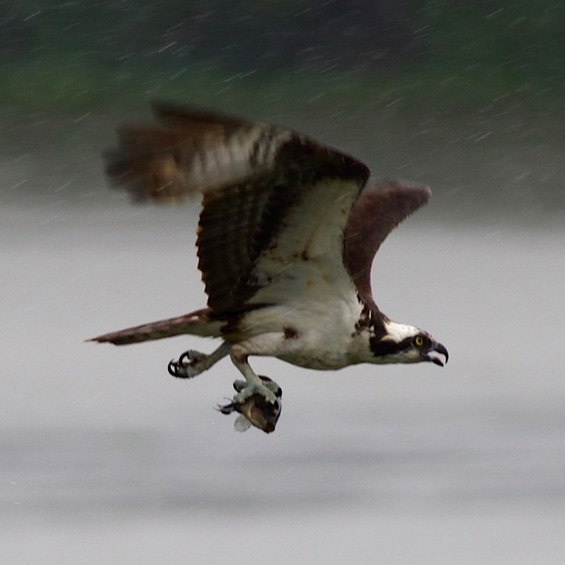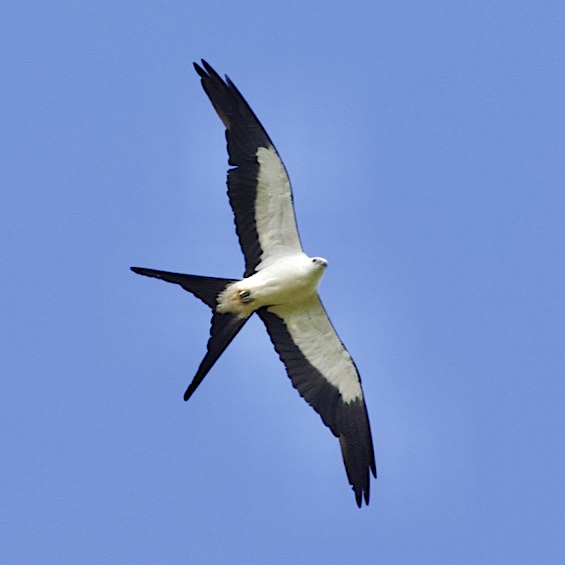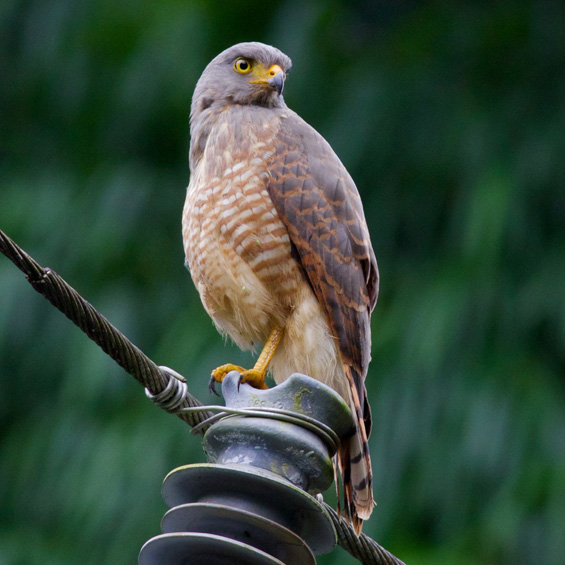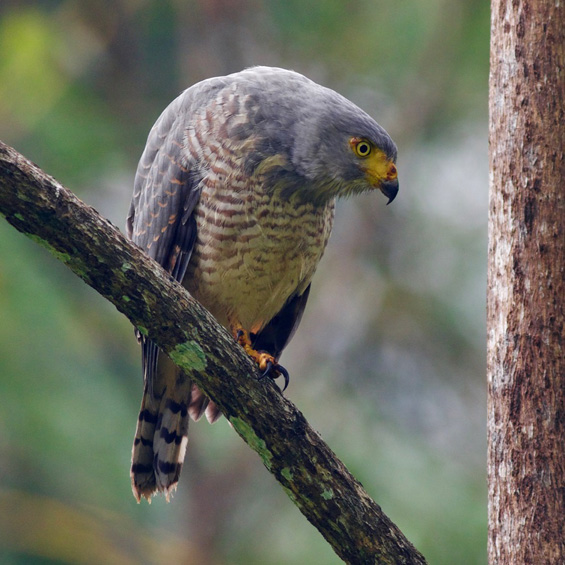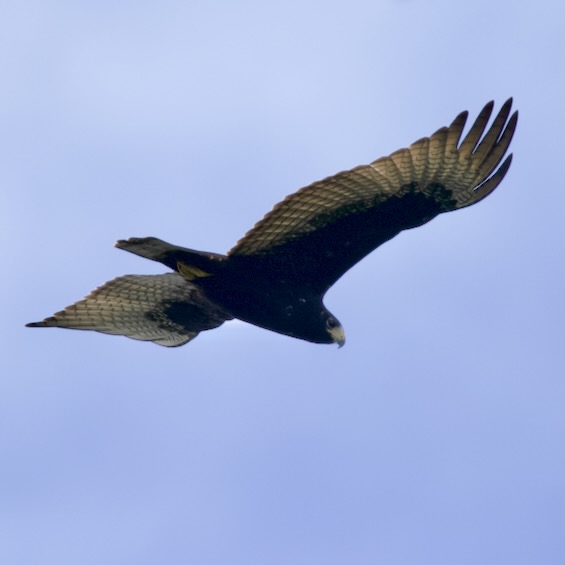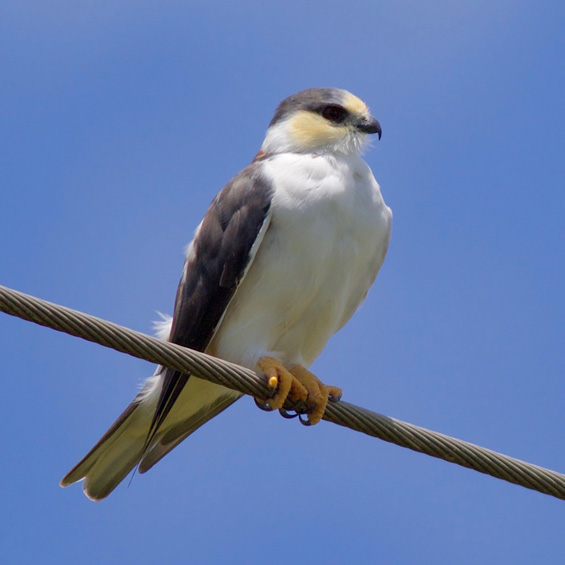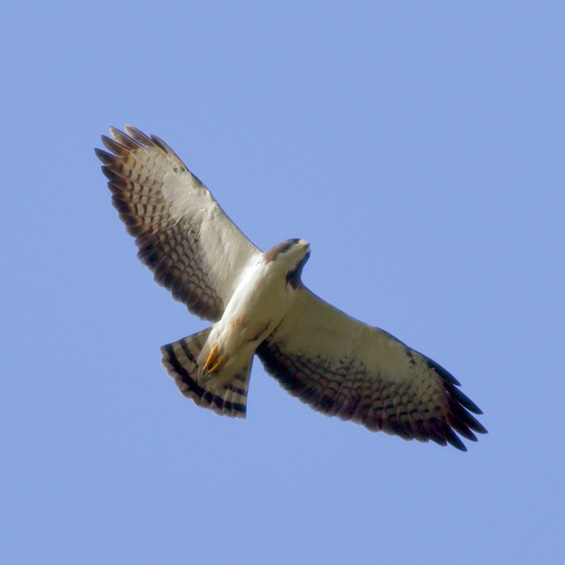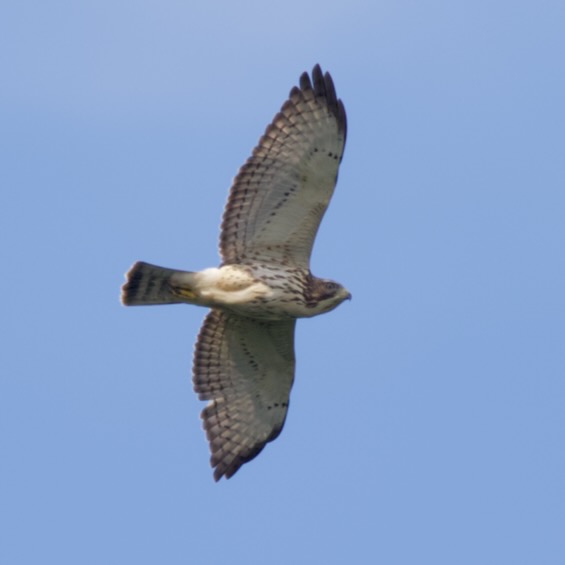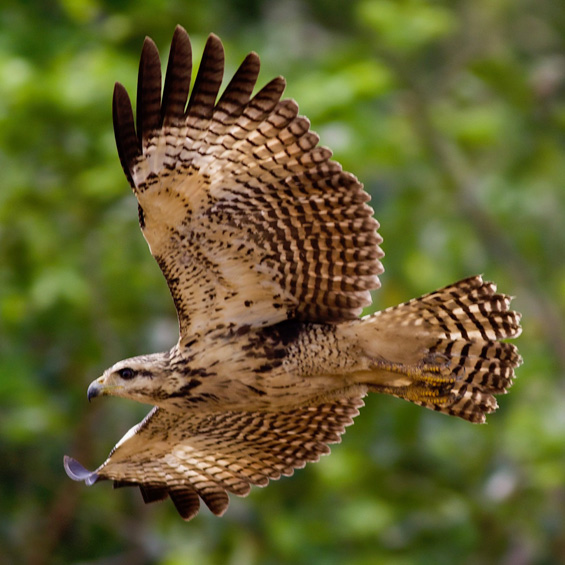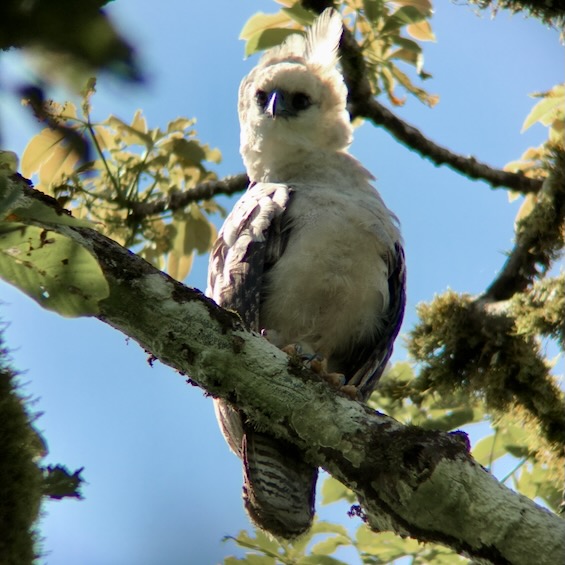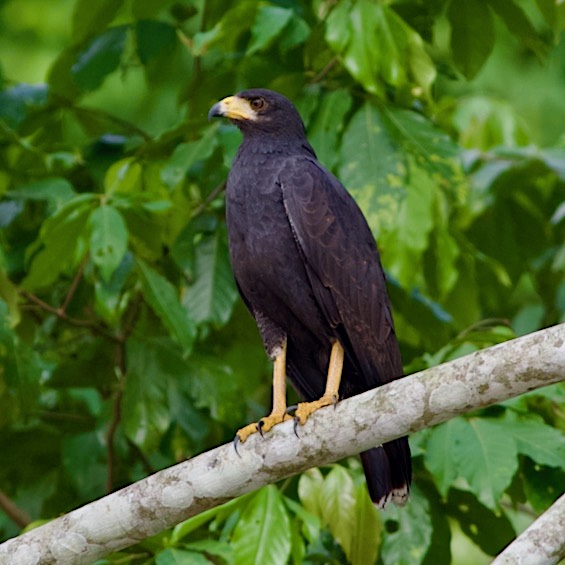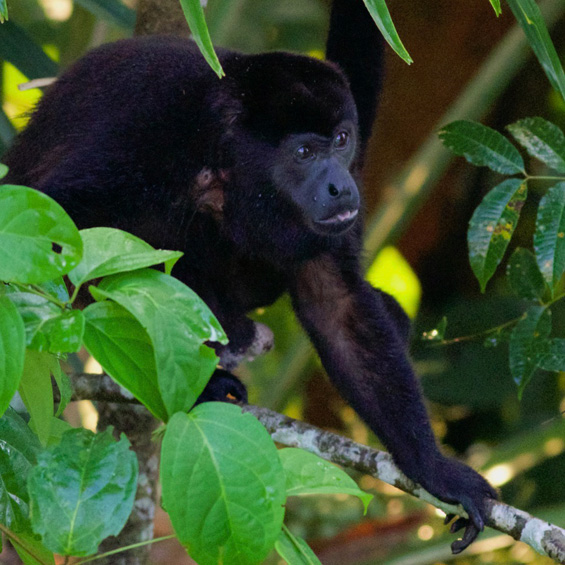Panama Birds and Coral Reefs
Panama Birds and Coral Reefs
And Harpy Eagle Tour Extension!
A Hawk Mountain Sanctuary Custom Raptour
THIS TOUR IS A CONFIRMED DEPARTURE
Share this!
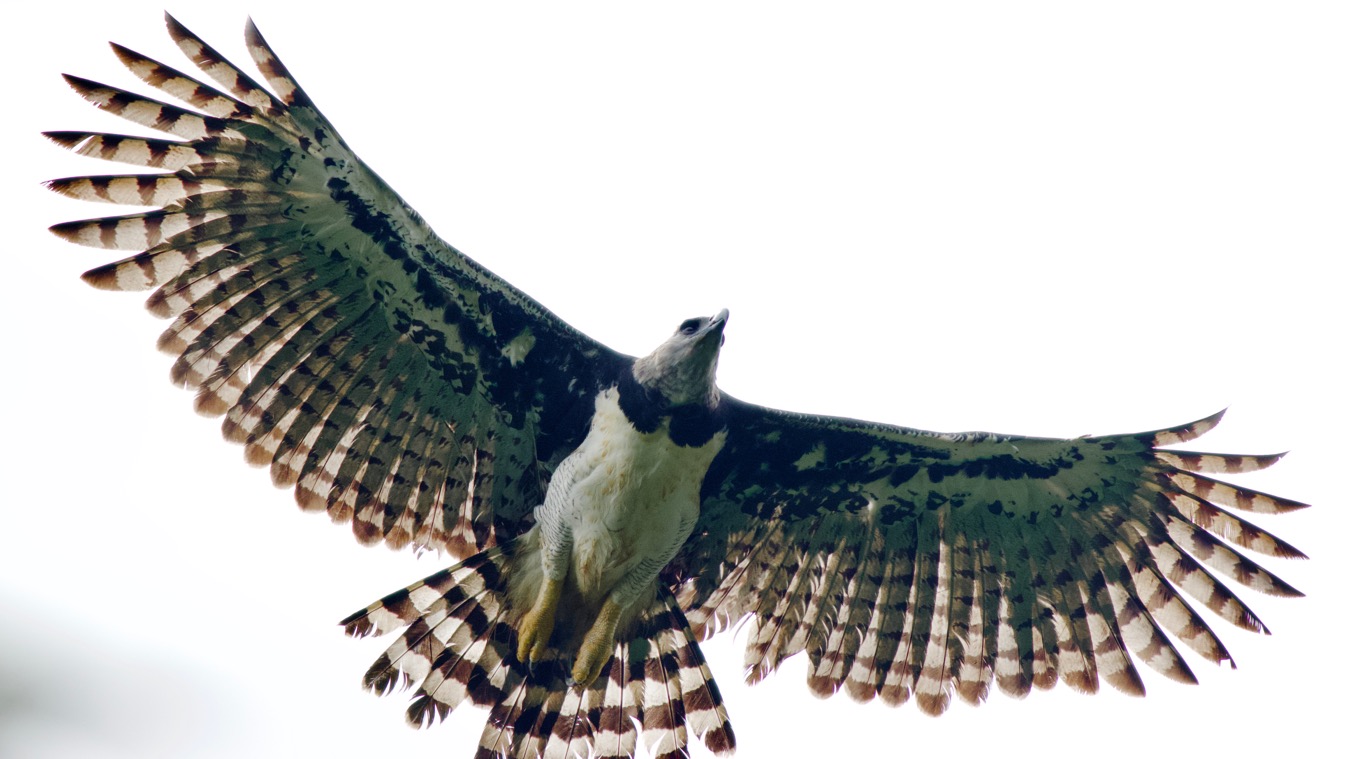
Few places in the world are so privileged a raptor destination as this relatively small country. Just a tad smaller than North Carolina, Panama boasts an impressive 55 species of diurnal birds of prey, and about 90% of them can be observed within a couple of hours' drive from Panama City!
We will visit birding areas in Central and Western Panama in the main tour, and we'll bird the exotic destinations in Eastern Panama during the tour Extension. Covering both the Pacific and Caribbean slopes, this is the most comprehensive Panama birding tour we have offered so far! Combining raptor-watching with regular birding and snorkeling, we expect to see 35 species of diurnal raptors, some 350 species of birds in total, and over 40 species of colorful tropical fish!
A Strategic Location
Sitting between two major land mases—North, and South America—Panama receives faunal influences from both. Northern Harriers and Sharp-shinned Hawks from North America regularly reach central Panama on their yearly southward migration; and both Gray-bellied Goshawk and Long-winged Harrier, formerly thought to occur only in South America, have been recently reported in the country.
Packed with Raptor Specialties
Panama's raptorial highlights include sought-after Neotropical specialties such as Gray-headed, Hook-billed, Plumbeous, Swallow-tailed, and Pearl Kites; Tiny, Plumbeous, Semiplumbeous, Zone-tailed, Gray-lined, and Barred Hawks; King, and Lesser Yellow-headed Vultures; plus near-threatened Crested, and Harpy Eagles. Charismatic species such as Black, and Ornate Hawk-Eagles and are also regularly observed soaring over the forest. Lucky birders may get good looks at most secretive Slaty-backed Forest Falcon.
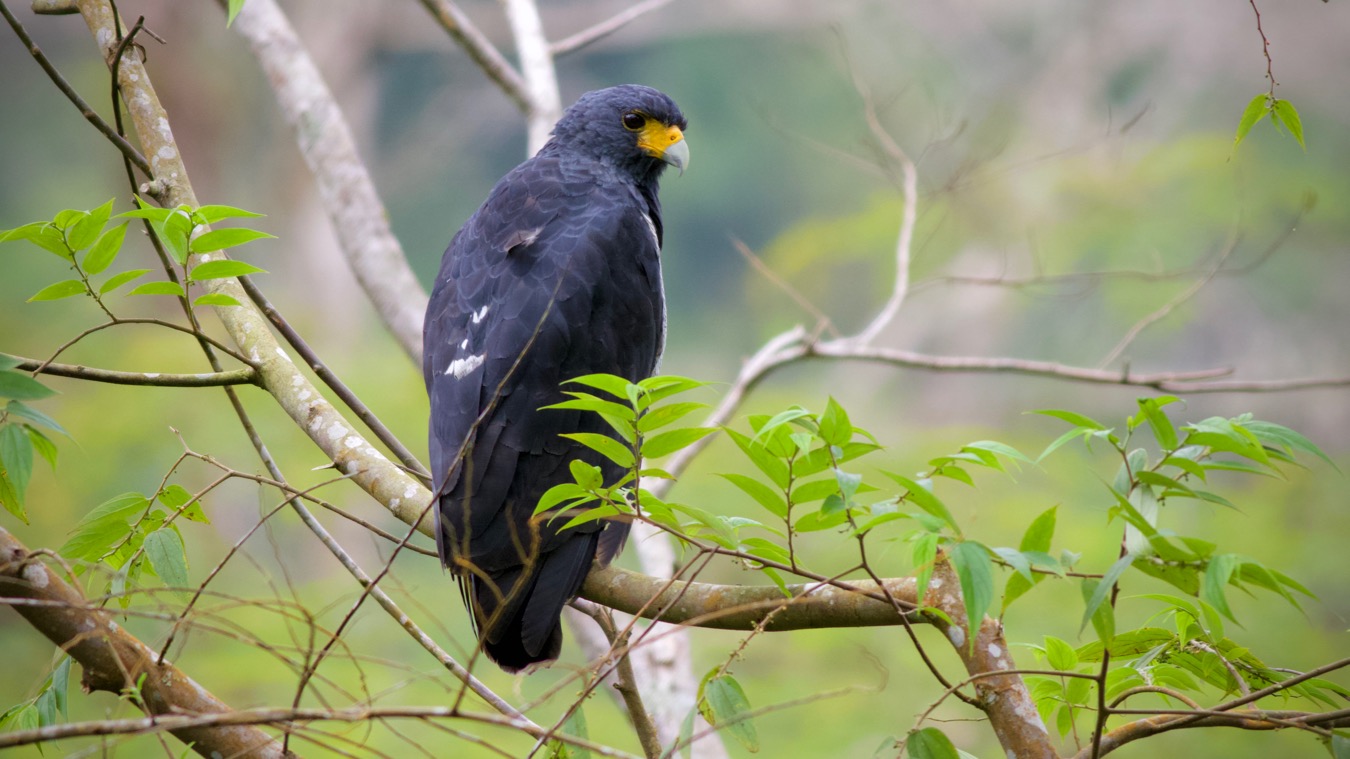
Hilly areas in Western Panama are among the most reliable places to see Barred Hawk, a taxonomic oddity that belongs in its own genus! It hunts from low perches, but also soars over the forest in good weather.
A World-Significant Migration Corridor
The Isthmus of Panama is the narrowest point of the Mesoamerican Biological Corridor, a natural land bridge for migratory species on their yearly roundtrip journey between North, and South America. Raptor migration through Panama is one of the greatest wildlife spectacles of the Americas. Every year, millions of Turkey Vultures, Swainson's Hawks, and Broad-winged Hawks are funneled into this narrow pass on their intercontinental migration. Fairly large numbers of Mississippi Kites are also seen.
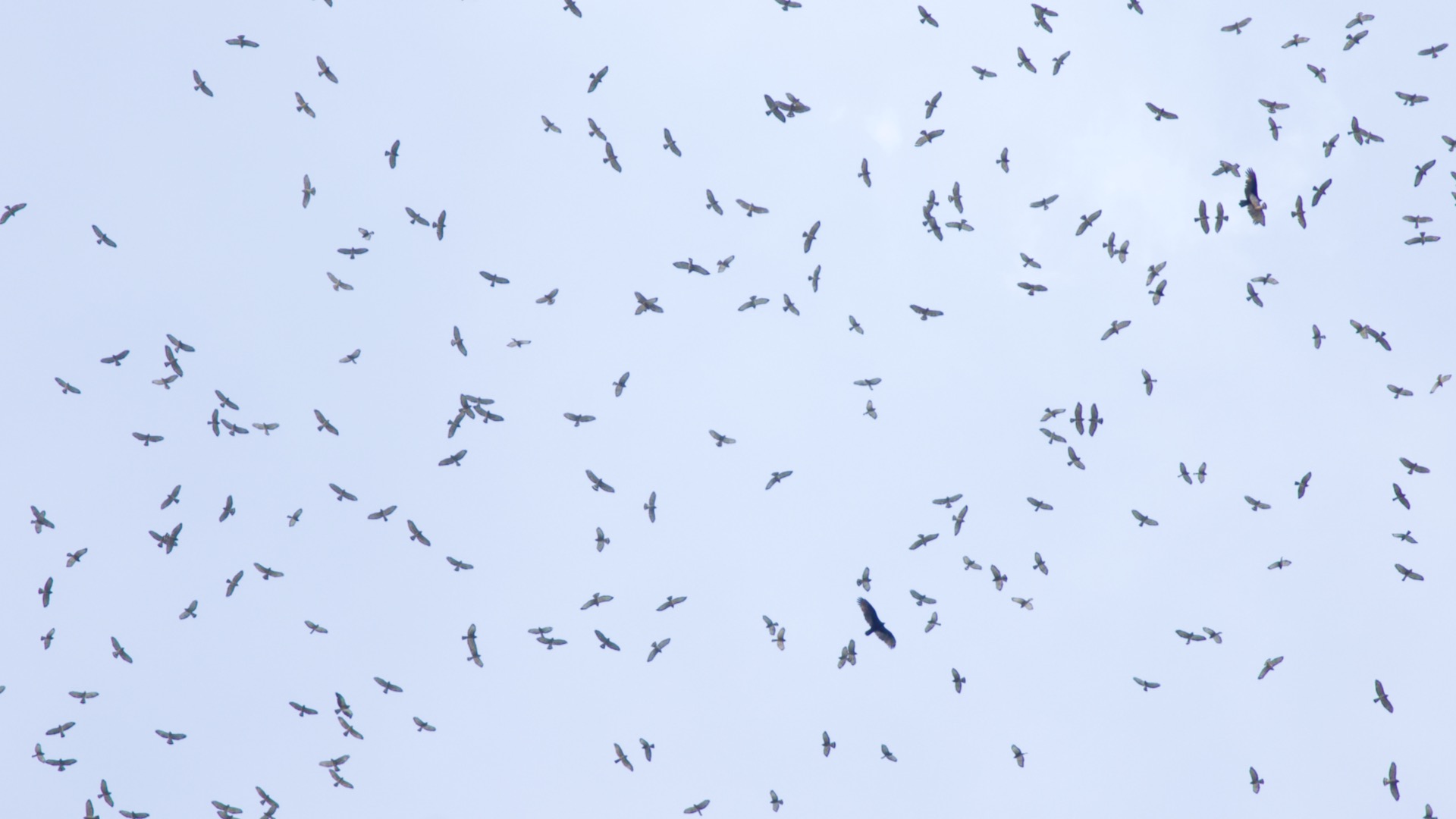
Raptor Migration, Quetzals, and Coral Reefs in the NW!
On this comprehensive tour we will visit the far western birding areas of Panama including Bocas del Toro and the Highlands of Chiriqui. Bocas is one of the most beautiful archipelagos in the Caribbean. Not only it boasts healthy coral reefs home to a myriad sea creatures, but it also lies right underneath a major raptor migration flyway! We will target non-migratory raptor specialty, and taxonomic odd-ball Barred Hawk in the mainland. We will combine raptor migration watching, mostly in the mornings, with kayaking, and snorkeling outings in the afternoons to experience Bocas like never before! Crossing the continental divide to the Pacific side we will target highland specialties such as Resplendent Quetzal!

Great General Birding
In addition to being one of the finest hawk-watching destinations on Earth, Panama also features great general birding. Therefore, a dedicated and experienced local birding guide will be with us at all times to help us find and identify non-raptorial birds as well. When raptors are not being watched we may also enjoy a variety of tropical birds including tinamous; ducks; guans and chachalacas; herons and egrets; wood-rails; jacanas; doves, ground-doves, and pigeons; parrots and parakeets; cuckoos and anis; owls; hermits, sicklebills, jacobins, mangos, plumeteers, and hummingbirds; trogons; motmots; kingfishers; puffbirds; jacamars; barbets, aracaris, toucanets, and toucans; woodpeckers; spinetails and woodcreepers; antshrikes, antvireos, and antbirds; tyrant flycatchers of various sorts, habits and sizes; becards and tityras; colorful cotingas; manakins; vireos, greenlets, shrike-vireos, and peppershrikes; swallows; wrens; thrushes; warblers; stunning tanagers and allies; seedeaters and finches; grosbeaks and ant-tanagers; icterids large and small; and euphonias, of course. See individual days in the itinerary below for more details on where to expect what and when.
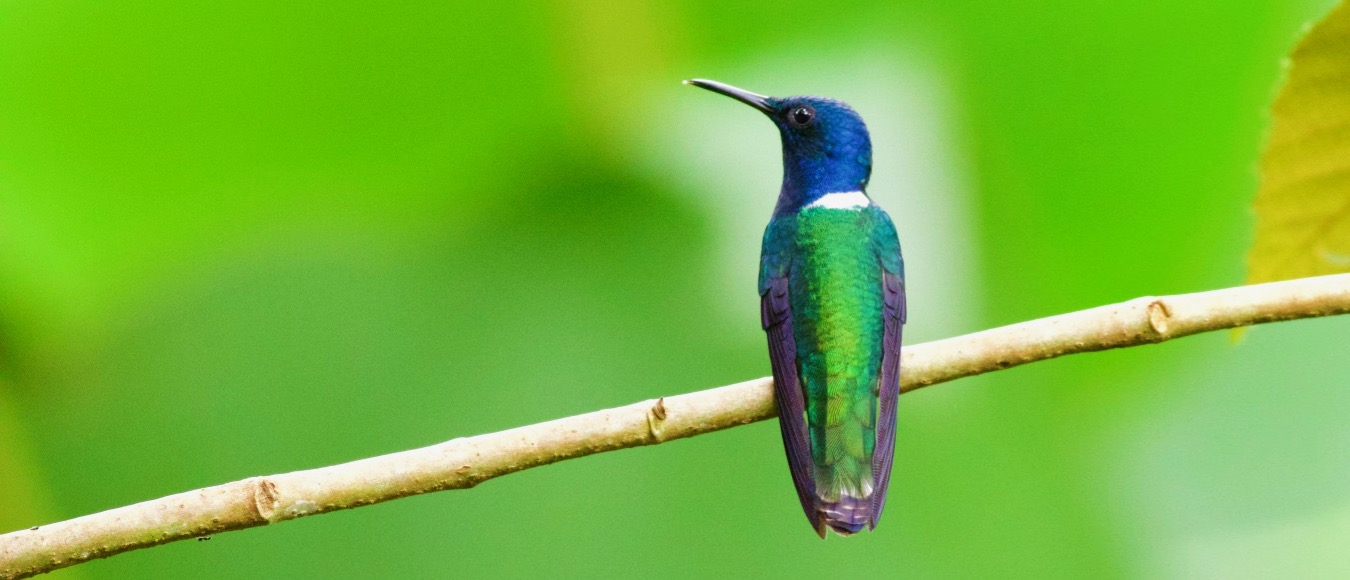
Make A Difference!
Raptours®, L.L.C. makes a financial contribution to Hawk Mountain Sanctuary for every member that signs up for this tour. Join us on this tour and make a lasting contribution to raptor conservation!
Main Tour Day-by-Day Itinerary
Day 1
Arrival at Tocumen International Airport (IATA code PTY) in the afternoon, where you will be met by a Raptours representative, and transfer to the Riande Airport Hotel nearby either individually or in small groups, depending on arrival times. Plan to arrive before 3 pm. 5:30 pm, icebreaker cocktails at the hotel bar and introductions. 6:30 pm, dinner. Overnight at the hotel.
Day 2
Breakfast and check-out. Bird the Metropolitan Natural Park or an alternative area nearby. 12:00 pm, lunch. Then head to the domestic airport to catch a flight to Bocas del Toro (2:00 pm – 3:10 pm). Transfer to Tranquilo Bay, our base for the next few days on the Bastimentos island. Snorkel the reefs in the afternoon. Up to 35 species of fish are possible in a single 1-h dip! Dinner and overnight at Tranquilo Bay.
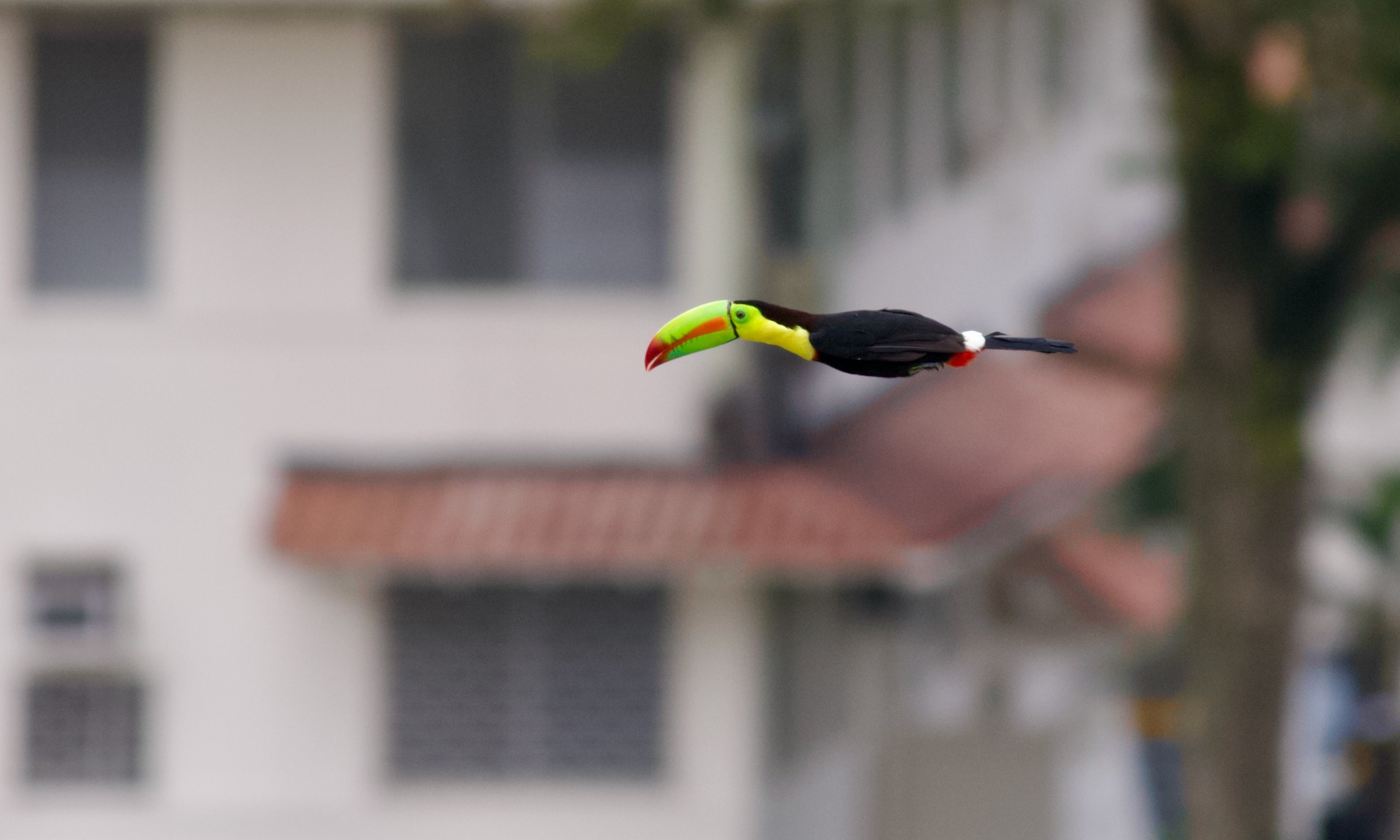
Day 3
Early start today. All-day excursion to Los Naranjos for Resplendent Quetzal, looking for Barred Hawk and other birds as well. Lunch near noon. Then, drive back to Tranquilo Bay, making stops to bird along the way. Dinner and overnight at Tranquilo Bay.
Day 4
Breakfast at Tranquilo, then head to the mainland to bird the Tierra Oscura Rd. Back at the lodge we'll get up on the observation tower to enjoy the birds from above and perhaps some raptor migration. Lunch at Tranquilo. In the afternoon we will explore the gardens and trails of Tranquilo, and take a second dip in the coral reefs! Dinner and overnight at Tranquilo Bay.
Day 5
Breakfast at Tranquilo. Explore the local trails or check-out and head back to the mainland to watch the raptor migration (depending on the flight). Catch our flight back to Panama City (2:30 pm – 3:30 pm). Shuttle to the Canopy Lodge in Valle Antón (2 hs). Check-in and relax for a bit. 6:30 pm, dinner. Overnight at the Canopy Lodge.
Day 6
6:00 am, meet to bird the garden. 6:30 am, breakfast. 7:30 am-12:00 pm, road to Altos del María and Cerro Gaital to target Swallow-tailed Kite, White Hawk, Barred Hawk, and Bat Falcon. Watch migrants from Cerro Gaital. 1:00 pm, back at the lodge for lunch. Relax in the afternoon or visit the handicraft market in El Valle. 6:30 pm, dinner. 7:30-8:00 pm, optional owling on the lodge trails. Overnight at the Canopy Lodge.

Other bird highlights in this area include Black Guan; White-tipped Sicklebill, Rufous-crested Coquette, Crowned Woodnymph, and Black-throated Mango, White-tailed Emerald, Green-crowned Brilliant, Violet-headed Hummingbird; Orange-bellied Trogon; Spot-crowned Barbet, and Blue-throated Toucanet; Spotted Barbtail, and Spotted Woodcreeper; Spot-crowned Antvireo, and Slaty Antwren; Black-headed Antthrush; Bran-colored Flycatcher, and Scale-crested Pygmy-Tyrant; Cinnamon Becard; Pale-vented Thrush; Rufous-capped Warbler; Common Bush-Tanager, plus Silver-throated, Golden-hooded, Tawny-crested, and Bay-headed Tanagers; and Scarlet-thighed Dacnis; Blue Seedeater; Black-faced Grosbeak; and Tawny-capped Euphonia.
Day 7
6:00 am, breakfast. Then checkout and morning excursion to coastal Pacific dry forest and rice fields to target Lesser Yellow-headed Vulture, Pearl Kite, White-tailed Kite, Roadside Hawk, Gray-lined Hawk, Savanna Hawk, Common Black Hawk, White-tailed Hawk, and with a bit of luck, Aplomado, and Peregrine Falcons. Also, to watch the raptor migration. Picnic lunch at Santa Clara. Then head to the Canopy Tower. Check-in and relax. 6:30 pm, dinner. Overnight at the Canopy Tower.
Other birds we may see today include Crested Bobwhite; Great Blue Heron, Tricolored Heron, and Black-crowned Night-Heron; Glossy Ibis; Gray-necked Wood-Rail; Southern Lapwing; Blue, and Plain-breasted Ground-Doves; Brown-throated Parakeet; Ferruginous Pygmy-Owl; Common Potoo; near-endemic Veraguan Mango, and Sapphire-throated Hummingbird; Pale-breasted Spinetail, and Straight-billed Woodcreeper; Mouse-colored Tyrannulet, Fork-tailed Flycatcher, Northern Scrub-Flycatcher, and Pale-eyed Pygmy-Tyrant; Golden-fronted Greenlet, and Rufous-browed Peppershrike; Grassland Yellow-Finch; and Red-breasted Blackbird, and Crested Oropendola.
Day 8
5:00 am, breakfast. 6:00-9:30 am, Quebrada Juan Grande and Pipeline Road to target Semiplumbeous Hawk, Tiny Hawk, and (early in the morning) Slaty-backed Forest Falcon. Other raptors likely to be seen here include Double-toothed Kite, and with a bit of luck, Gray-headed Kite and Crane Hawk. Agami Heron, Sunbittern, Dull-mantled Antbird, and Sapayoa are sometimes seen along the streams intersected along the road. 10:00 am through noon, watch the migration and resident raptors from the tower at the Panama Rainforest Discovery Center where Tiny and Semiplumbeous Hawks are sometimes seen. 12:30 pm, box lunch at the Visitor Center where we can probably see Golden-collared Manakin, Long-billed Hermit, White-necked Jacobin, Violet-crowned Woodnymph, and up to ten species of hummers. 4:00-6:00 pm, visit Summit Ponds. 6:30 pm, dinner at the Canopy Tower.
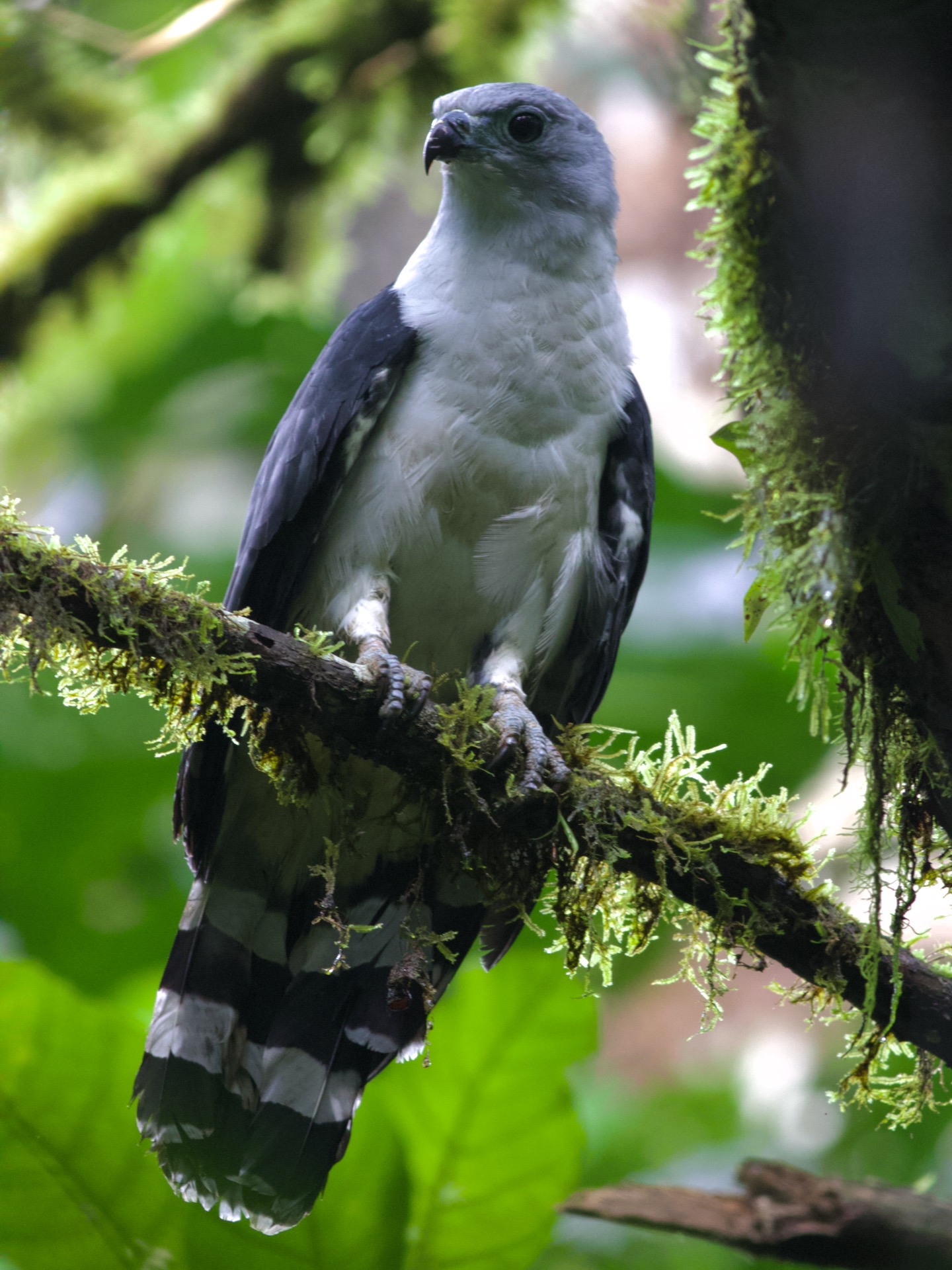
Other highlights today may include Slaty-tailed Trogon, and Cocoa Woodcreeper. Little Tinamou; Gray-headed Chachalaca; Gray-necked Wood-Rail; Blue Ground-Dove; Greater Ani, and Squirrel Cuckoo; Purple-crowned Fairy; Gartered, Slaty-tailed, Black-throated, White-tailed, and Black-tailed Trogons; White-necked Puffbird; Fasciated, and Black-crowned Antshrikes, plus White-bellied, and Dusky Antbirds; Yellow Tyrannulet, Forest Elaenia, Southern Bentbill, plus Panama, and Streaked Flycatchers; Masked Tityra; Blue Cotinga; Golden-collared Manakin; Green Shrike-Vireo; Plain, Black-bellied, and Buff-breasted Wrens; Rosy Thrush-Tanager; Red-throated Ant-Tanager; and Yellow-tailed Oriole.
Day 9
5:30 am, meet at the parking lot deck and target Barred, and Collared Forest Falcons. 6:30 am, breakfast. 7:00-9:00 am, look for perched raptors including Double-toothed Kite, Gray-headed Kite, Gray-lined Hawk, Crane Hawk, or Semiplumbeous Hawk from tower observation deck. Non-raptorial highlights at the tower include Blue Cotinga, and Green Shrike-Vireo, toucans, and a wide array of tanagers, and mammals like three-toed sloth, Geoffroy's tamarins, Black Howler Monkeys, and Coatimundi. Later in the morning, the migration will pick up (weather conditions permitting), and we may also see some resident soaring species such as White Hawk, Short-tailed Hawk, Zone-tailed Hawk, or Black Hawk-Eagle. 1:00 pm, lunch and checkout. Shuttle to the airport where the tour ends… or stay another night at the Canopy Tower if you choose to join the Harpy Eagle Tour Extension!
Harpy Eagle Extension
The main goals of this extension are to watch Harpy, and Crested Eagles, and target Plumbeous, and Semiplumbeous Hawk, plus Red-throated Caracara. Success with the first two will largely depend on the status of known nesting sites at the time the tour is conducted. Please note that predation or other disruptive events can happen suddenly and without warning, causing nest failure, and sometimes, desertion of territories by breeding adults. Only participants of the main tour can signup for the extension.

Day 1
After eating lunch at the Canopy Tower, we'll take it easy: siesta break. 3:00-6:00 pm, bird the Old Gamboa Rd, where Great Antshrike, Jet Antbird, Pale-eyed Pygmy-Tyrant, and Bran-colored Flycatcher are all realistic possibilities. Lucky birders get their Boat-billed Heron here. 6:30 pm, dinner at the Canopy Tower.
Day 2
Early check out and head for Burbayar. Target Plumbeous Hawk upon arrival, and other birds and raptors later in the morning. Lunch in Burbayar. Drive to Darién in the afternoon. 6:30 pm, dinner at the Darién Camp. Overnight at the Darién Camp.
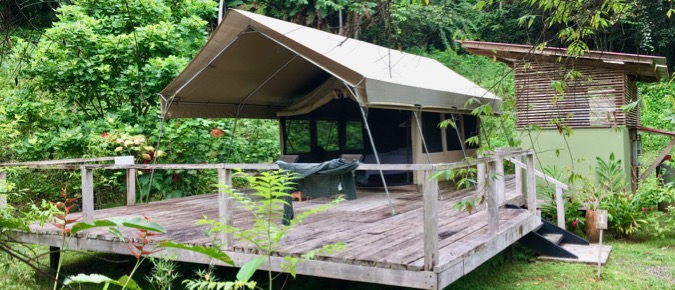
Day 3
Pre-dawn walk in the camp’s trails to target Collared, and Slaty-backed Forest Falcons. Breakfast back at the camp. Then target Semiplumbeous Hawk on the same trails. Lunch at the camp. Target open habitat raptors including Lesser Yellow-headed Vulture and Pearl Kite, and other birds in the afternoon. Dinner and overnight at the Darién Camp.
Day 4
Breakfast time TBA. All-day excursion to visit a Crested Eagle breeding site (if active at the time of the tour), and access road conditions permit. Otherwise target raptors such as Pearl Kite, Red-throated Caracara, Crane Hawk, and Semiplumbeous Hawk, and other raptors at various locations. Dinner and overnight at the Darién Camp.
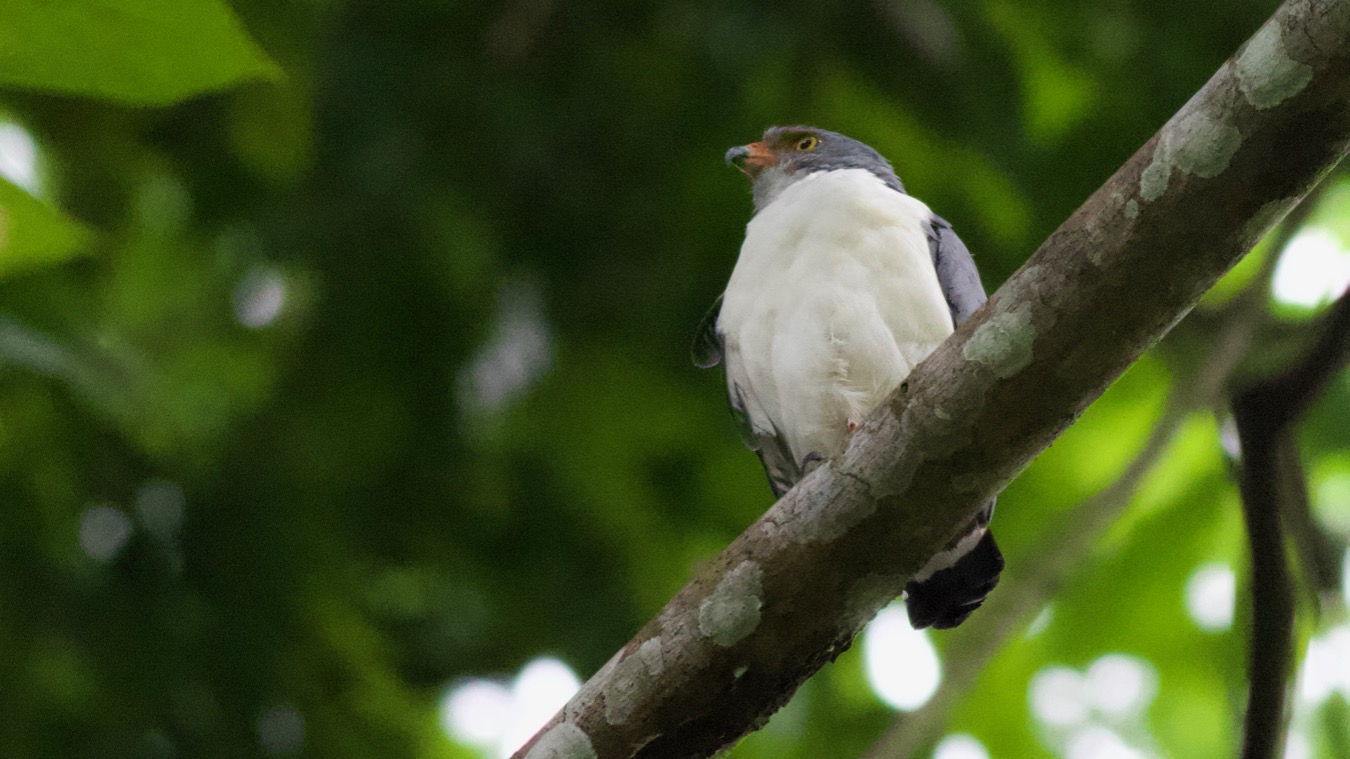
Day 5
Breakfast time TBA. All-day excursion to visit an active breeding site of Harpy Eagle (if active at the time of the tour). Picnic lunch. 6:30 pm, dinner at the Camp. Overnight at the Darién Camp.
Day 6
6:30 am, breakfast and check-out. Drive back to Panama City where the tour extension ends at 3:00 pm at the airport or, if you plan to stay a little longer in town, we can drop you off at your hotel.
Target Species
common name
- Turkey Vulture (LC)
- Lesser Yellow-headed Vul. (LC)
- Black Vulture (LC)
- King Vulture (LC)
- Osprey (LC)
- White-tailed Kite (LC)
- Pearl Kite (LC)
- Hook-billed Kite (LC)
- Swallow-tailed Kite (LC)
- Crested Eagle (NT)
- Harpy Eagle (NT)
- Black Hawk-Eagle (LC)
- Black-and-white Hawk-Eagle (LC)
- Ornate Hawk-Eagle (NT)
- Double-toothed Kite (LC)
- Tiny Hawk (LC)
- Bicolored Hawk (LC)
- Mississippi Kite (LC)
- Black-collared Hawk (LC)
- Snail Kite (LC)
- Crane Hawk (LC)
- Plumbeous Hawk (VU)
- Common Black Hawk (LC)
- Savanna Hawk (LC)
- Great Black Hawk (LC)
- Barred Hawk (LC)
- Roadside Hawk (LC)
- White-tailed Hawk (LC)
- White Hawk (LC)
- Semiplumbeous Hawk (LC)
- Gray-lined Hawk (LC)
- Broad-winged Hawk (LC)
- Short-tailed Hawk (LC)
- Swainson's Hawk (LC)
- Zone-tailed Hawk (LC)
- Red-throated Caracara (LC)
- Crested Caracara (LC)
- Yellow-headed Caracara (LC)
- Laughing Falcon (LC)
- Barred Forest Falcon (LC)
- Slaty-backed Forest Falcon (LC)
- Collared Forest Falcon (LC)
- American Kestrel (LC)
- Merlin (LC)
- Bat Falcon (LC)
- Peregrine Falcon (LC)
latin name
- Cathartes aura
- Cathartes burrovianus
- Coragyps atratus
- Sarcoramphus papa
- Pandion haliaetus
- Elanus leucurus
- Gampsonyx swainsonii
- Chondrohierax uncinatus
- Elanoides forficatus
- Morphnus guianensis
- Harpia harpyja
- Spizaetus tyrannus
- Spizaetus melanoleucus
- Spizaetus ornatus
- Harpagus bidentatus
- Hierazpiza superciliosa
- Astur bicolor
- Ictinia mississippiensis
- Busarellus nigricollis
- Rostrhamus sociabilis
- Geranospiza caerulescens
- Cryptoleucopteryx plumbea
- Buteogallus anthracinus
- Buteogallus meridionalis
- Buteogallus urubitinga
- Morphnarchus princeps
- Rupornis magnirostris
- Geranoaetus albicaudatus
- Pseudastur albicollis
- Lecopternis semiplumbeus
- Buteo nitidus
- Buteo platypterus
- Buteo brachyurus
- Buteo swainsoni
- Buteo albonotatus
- Ibycter americanus
- Caracara cheriway
- Milvago chimachima
- Herpetotheres cachinnans
- Micrastur ruficollis
- Micrastur mirandollei
- Micrastur semitorquatus
- Falco sparverius
- Falco columbarius
- Falco rufigularis
- Falco peregrinus
Suggested Field Guide
Angehr, G.R., and R. Dean. 2010. The Birds of Panama: A Field Guide. Paperback Edition. A Zona Tropical Edition Publication, Cornell University Press, Ithaca and London.
Need to Know
Tour Dates & Availability
Main Tour 14–22 April 2025 | 7 Places
Tour Extension 22-27 April 2025 | 9 Places
Group Size Limits
Main Tour 8-14 Participants
Tour Extension 6-10 Participants
Tour Price
Main Tour price is US$6,450 and includes all accommodations (double occupancy), domestic flights to and from Bocas del Toro, ground transportation while in Panama, all meals starting with dinner on 14 April, and ending with lunch on 22 April, all non-alcoholic drinks at meals and in the field, local guide fees, and all entry fees and excursions.
Tour Extension price is US$3,550 and includes all accommodations (double occupancy), ground transportation, all meals starting with dinner on 22 April, and ending with lunch on 27 April, all non-alcoholic drinks at meals and in the field, local guide fees, and all entry fees and excursions.
International fare to and from Panama City, extra nights in Panama, alcoholic beverages, items of personal nature, laundry, tips, and insurance of any kind are not included.
A non-refundable Registration Fee of US$750 will be requested at the time of booking. This fee counts against the total tour price.
Single Supplement
Main Tour $600
Tour Extension $350
Single rooms will be subject to availability.
Roommates will be assigned to those participants willing to share a room. If a roommate is not available, you will be required to pay the single supplement.
Booking & Payment
Fill out the online booking form at your earliest convenience. Participants will be accepted on a first come, first served basis. Participants booking both the main tour, and the tour extension will be given priority over those booking the main tour only.
Once your application information is reviewed, the non-refundable Registration Fee will be requested.
Once the minimum number of 8 participants is attained, the balance, plus any applicable Single Supplement fees will be requested. Participants paying with wire transfer will get a $25 discount per payment.
If by 1 January 2025 the minimum number of 8 participants has not been attained your Reservation Fee will be refunded.
Trip Cancellations
All cancellation requests must be made in writing to Raptours, L.L.C.
Cancellations requested before 1 January 2025 will be subject to a full refund minus the non-refundable reservation fee ($750).
No refunds will be made for cancelations requested on 1 January 2025 or after. No exceptions.
Raptours, L.L.C. reserves the right to cancel the tour at any time with full refund (including the Registration Fee) to participants.
Travel cancellation insurance is recommended.
Tipping
At Raptours we believe that tipping should be non-compulsive and personal, so we leave it up to participants to tip waiters, porters, guides, drivers, and others that will aid us achieve our goals, based entirely on merit. “Group-tipping”, if necessary, should be coordinated with your tour leader.
Country Entry Requirements
You will need a passport valid for at least three months past the date of entry, a return ticket to your home country or onward destination, and either US$ 500 in cash or its equivalent, or a credit card.
Difficulty
Easy to Moderate
No strenuous walks or hikes involved, but trails will be wet, muddy, and slippery. We will adapt the pace so that all participants enjoy the walks. There might be some gentle slopes to negotiate. These may be slippery. You may need a walking pole if you sometimes have difficulties maintaining your balance. You will need to climb a few flights of stairs at the Canopy Tower as there are no elevators here: bedrooms, dinning room, and observation deck are at different levels. Boat rides 1-3 hs in duration may be required to get to our birding destinations.
Comfort
Comfortable rooms with private bathrooms throughout. Hotel rooms will have either AC or fans. Essential free wi-fi will be available either in rooms or public areas. We will travel in comfortable vehicles, but AC use will be kept to a strict minimum or avoided altogether on short rides; humidity is so high that otherwise cameras and binoculars will get foggy as soon as we step out of the vehicle!
Weather
Temperature typically varies from 75 °F to 90 °F (24–32 °C) and is rarely below 74 °F (23 °C) or above 93 °F (34 °C). Expect mostly cloudy or overcast days, with some breaks. Chance of rain will be about 40% on a daily basis. Humidity will be very high in the Canal Zone and in the Darien! Expect it to be oppressive about 40% of the time (dew point 70-75 °F), and miserable about 60% of the time (dew point over 75 °F). Weather feels nicer at higher elevations around Valle Antón and up.
Clothing
Humidity and temperature dictates lightweight clothing. Long-sleeved shirts and pants offer protection against mosquito bites and UV radiation. Trails will be muddy, and you'll need waterproof shoes with good traction. Make sure to bring long-sleeved, but lightweight clothing, a brim hat, and a folding umbrella or a rain poncho.
Health
Pregnant women should not travel to Panama because Zika infection during pregnancy can cause serious birth defects.
Yellow fever vaccination recommended for all travelers.
Malaria chemoprophylaxis recommended (atovaquone-proguanil, doxycycline, mefloquine, or primaquine). Drug resistance to Chloroquine has been documented.
All travelers should follow steps to prevent mosquito bites during and after their trip.
Visit CDC's website at least 6 weeks before departure.
Local Currency
US Dollar
Tour Leader

Raptours, LLC owner Sergio Seipke loves to share his passion for raptors with others. He has been numerous times to Panama to watch and photograph raptors, and after traveling extensively chasing birds of prey, he thinks that this is one of the top hawk-watching destinations in the world. Sergio speaks English and Spanish, he is quite personable, and is always eager to help others find, see, and identify raptors in the field. In fewer words, Sergio is OK...
Co-Leader
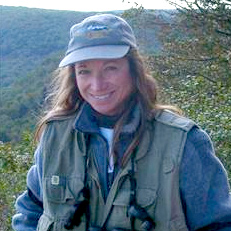
Raptor World Legend Laurie Goodrich, PhD., is Sarkis Acopian Director of Conservation Learning at Hawk Mountain. Laurie has led birdwatching trips since 1994 and never tires of watching the migration. She received her Master’s in Ecology from Rutgers University and her Ph.D from Penn State University. In addition to running the Conservation Learning program at HMS, Laurie is currently involved in research on raptor migration and movement ecology in North, Central and South America.
Tour Showcase
Terms
Raptours, L.L.C. reserves the right to alter this itinerary as necessary, or to cancel the tour prior to departure, with full refund to participants.
Raptours, L.L.C. or its agents may decline to accept or retain any person as a member of this tour at any time.
No smoking will be permitted while with the group, either when indoors or in the field.
Travel medical insurance is strongly recommended.
All passengers will be required to sign a hard copy of the Release of Liability and Assumption of Risk form upon meeting with the tour leader in Panama.
No participants will be allowed in the group without a signed copy of the Release of Liability and Assumption of Risk form.
Release of Liability and Assumption of Risk Form
(including Terms)
![]()


